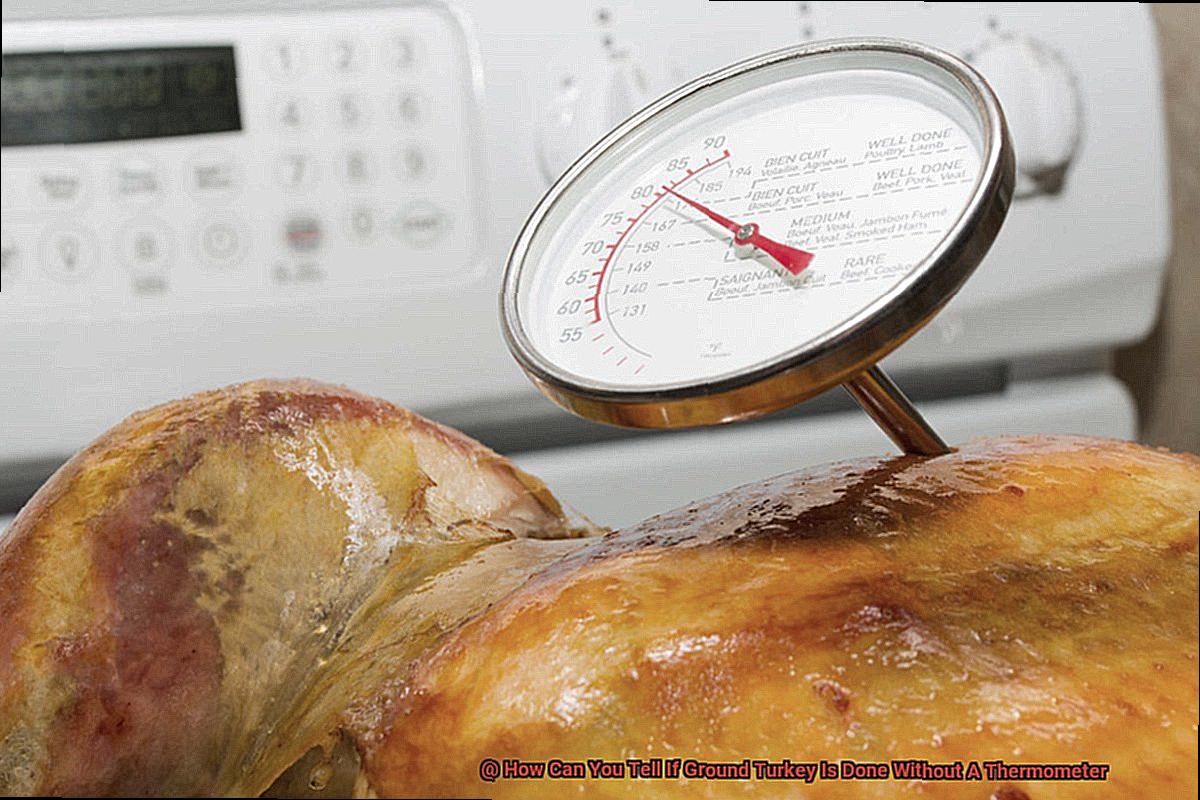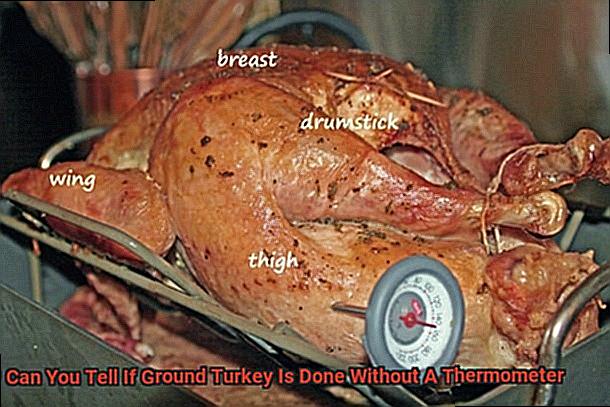The holiday season is just around the corner, and it’s time to start planning those delicious home-cooked meals. One ingredient that’s sure to make an appearance on many tables is ground turkey. With its lower fat content, it’s a healthier alternative to beef in many recipes. However, cooking ground turkey can be tricky, especially if you don’t have a thermometer on hand. Undercooked meat can lead to health problems and no one wants that.
So, how can you tell if ground turkey is done without a thermometer? While using a thermometer is the most accurate way to determine the internal temperature of your meat, there are other tricks you can use to ensure it’s fully cooked. In this blog post, we’ll explore some effective techniques for determining if your ground turkey is safely cooked through.
We’ll cover everything from the color and texture of the meat to the juices and cooking time. By paying attention to these important markers, you’ll be able to tell if your ground turkey is fully cooked without relying on a thermometer. By the end of this post, you’ll have all the tips and tricks you need to cook perfect ground turkey every time – no thermometer required.
Contents
Why it is Important to Cook Ground Turkey Properly
Undercooked meat can result in severe food poisoning symptoms and even contaminate other foods and surfaces in your kitchen. Here are some reasons why you should always cook your ground turkey to the recommended internal temperature of 165°F:
- Avoiding Foodborne Illness: Ground turkey can be a breeding ground for harmful bacteria such as salmonella and E. coli. These bacteria can cause severe food poisoning symptoms, including nausea, vomiting, diarrhea, and even death in extreme cases. By cooking your ground turkey properly, you can ensure that these bacteria are killed off and your meat is safe to eat.
- Maintaining Texture and Flavor: Raw or undercooked turkey can have a rubbery texture and a bitter taste that can ruin the overall quality of your meal. Cooking your ground turkey to the recommended temperature will result in tender meat with a delicious flavor that you and your family will savor.
- Preventing Cross-Contamination: Undercooked meat can spread bacteria to other foods and surfaces in your kitchen, increasing the risk of foodborne illness. Properly cooking your ground turkey will reduce this risk of cross-contamination, making your kitchen a safer place to cook.
To ensure that your ground turkey is fully cooked and safe to eat, it is recommended to use a meat thermometer whenever possible. However, if you don’t have access to a thermometer, you can also check for color, texture, and clear juices as indicators of doneness.
Alternative Methods for Checking If Ground Turkey is Done Without a Thermometer
Cooking ground turkey can be a tricky task, especially when it comes to ensuring it’s fully cooked. While using a thermometer is the most reliable way to know if your meat is done, there are alternative methods that can come in handy if you don’t have one available.
One effective way to check if your ground turkey is cooked through is by examining its color and texture. Cooked meat should have an even brown color and appear slightly crispy on the outside. If you break the meat apart with a spatula, it should not release any pink juices or appear undercooked.
Another method is to use a fork to break off a small portion of the meat. Fully cooked ground turkey should appear white or light brown in color with no visible traces of blood. If there’s still some pinkness or rawness, then it needs more time on the stove.
In addition to these methods, you can also use your sense of touch to determine if your ground turkey is done. Gently press down on the meat with a spatula or fork – it should feel firm and not too soft or mushy. If it feels too soft, then it may still be undercooked and require additional cooking time.
It’s important to note that while these alternative methods may not be as accurate as using a thermometer, they’re still effective ways to ensure your ground turkey is cooked thoroughly and safe to eat. By being vigilant about checking for signs of doneness, you can minimize the risk of potential foodborne illnesses.
How to Check the Color and Texture of the Meat
No worries, we’ve got you covered. Here are a few ways to determine if your ground turkey is cooked through, based on its color and texture.
Color:
Cooked ground turkey should be brown throughout with no pink areas. Check both the inside and outside of the meat to ensure it’s fully cooked. If you see any pink areas, it needs more time on the stove. Keep in mind that ground turkey may still be safe to eat if slightly pink in the middle, but it’s always better to be safe than sorry and cook it until it’s completely brown.
Texture:
Another way to check for doneness is by looking at the texture of the meat. Cooked ground turkey should be firm and not slimy or mushy. To check its texture, press it gently with a fork or spoon. If it feels firm and no juices come out, it’s likely done. However, if it still feels soft and there are still juices coming out, it may need more time to cook.
Fork test:
You can also use the “fork test” to determine if your ground turkey is cooked through. Insert a fork into the thickest part of the meat and twist it slightly. If clear juices come out, it’s done. But if you see pink or red juices, it needs more time on the stove.
Timer:
The USDA recommends cooking one pound of ground turkey on medium heat for 14-16 minutes until it reaches an internal temperature of 165°F for safety. Use a timer as a general guide to avoid undercooking or overcooking your ground turkey.
Resting time:
After cooking your ground turkey, let it rest for a few minutes before serving to allow residual heat to continue cooking the meat and prevent it from drying out.
Using a Fork to Break Apart the Meat
There’s a simple and efficient way to determine whether your meat is fully cooked- using a fork to break apart the meat.
To start, grab a clean fork and visually inspect the meat as you break it apart. Remember to look for any pink or red spots in the thickest part of the turkey. If there are any present, then the turkey needs more time on the grill or stove. However, if the meat is no longer pink and is fully browned, it may be fully cooked. But wait, there’s more.
Breaking apart several different pieces of meat throughout the turkey is crucial to ensure that it is thoroughly cooked. This way, you can guarantee that there are no undercooked sections left that could make you sick. You wouldn’t want your taste buds excited for a delicious meal only to end up with food poisoning.
Using a fork to break apart the meat can also save you time and effort without compromising on safety. It eliminates the need for expensive equipment while still providing accurate results. Plus, it’s a great way to impress your guests with your culinary expertise.
Remember to wash your utensils thoroughly after each use to prevent cross-contamination. This helps maintain hygiene and ensures safe consumption of food.

Using a Timer as a General Guide
When it comes to cooking ground turkey, ensuring that it is fully cooked is crucial to avoid any harmful bacteria. While a thermometer is the most accurate way to measure the temperature of the meat, not everyone has one on hand. This is where using a timer comes in handy.
To start, heat up a non-stick skillet over medium heat and add your ground turkey. As it cooks, use a spatula to break it up into smaller pieces. Once the turkey has started to brown and develop some color on the outside, set your timer for 15-20 minutes depending on the amount of turkey being cooked.

After the timer goes off, grab a knife and cut into the thickest part of the turkey to check if it’s fully cooked. The internal color should be white or brown with no pink remaining. If there are still visible pink or red spots, continue cooking for an additional 5-10 minutes before checking again.

However, keep in mind that using a timer as a general guide may not always be accurate due to variations in meat thickness and stove heat level. Therefore, it is recommended to use this method in conjunction with other visual cues such as color and texture to ensure that your ground turkey is fully cooked.
Here are some additional tips for using a timer as a general guide when cooking ground turkey:
- Use a meat thermometer if available to double-check the temperature.
- Avoid overcrowding the pan as this can affect cooking time.
- Use lean ground turkey for quicker cooking times.
- Check for any visible signs of juice running clear from the meat.
The USDA’s Recommendations for Safety
As an expert on the USDA’s recommendations for safety, let me share some tips and tricks with you that will make cooking ground turkey a breeze.
The most critical recommendation from the USDA is to cook ground turkey to an internal temperature of 165°F. This ensures that any harmful bacteria present in the meat are killed. But what if you don’t have a thermometer? Don’t worry; there are other ways to tell if your turkey is done.
One method is to use visual cues. As the turkey cooks, its color changes from pink to brown. If there are any traces of pink or pink juices running from the meat, it needs further cooking. Additionally, pay attention to the texture of the meat; it should feel firm and no longer be squishy.
Another way is to use a fork or spatula to press down on the turkey patty or meatball. If the juices run clear, then it’s likely that the turkey is fully cooked. Any signs of pink or red in the juice mean that it needs more time on the heat.
You can also use a timer as a rough guide. The USDA recommends cooking ground turkey for at least 14-16 minutes over medium heat. But remember: this method should be used in combination with other methods since it’s not foolproof.
It’s crucial to note that while these methods can give you an idea of whether your ground turkey is done, using a meat thermometer is still the most reliable way to ensure that your food is safe to eat and prevent foodborne illness.
To summarize, cooking ground turkey doesn’t have to be stressful without a thermometer. By using these tips and tricks, you can cook your turkey perfectly and safely every time. In short, follow these steps:
- Cook ground turkey to an internal temperature of 165°F
- Look for visual cues like color and texture changes
- Use a fork or spatula to check if the juices run clear
- Use a timer as a rough guide, but combine it with other methods
The Pros and Cons of Using Alternative Methods Without a Thermometer
Not everyone has a meat thermometer in their kitchen. That’s why it’s essential to know the pros and cons of using alternative methods to determine if your meat is fully cooked.
One method is to visually inspect the meat. Cooked turkey should have an internal temperature of 165 degrees Fahrenheit and should no longer be pink in color. While this method is simple, it’s not always reliable. The color of the meat can vary, and some parts of the meat may cook faster than others.
Another alternative method is to use a timer. The USDA recommends cooking ground turkey for at least 14-16 minutes per pound on medium heat. While this method is helpful, it doesn’t account for variables such as the thickness of the meat or the accuracy of your stove’s temperature.
While these alternative methods without a thermometer might seem convenient, they have their pros and cons. One pro is that they’re simple and require no extra tools or equipment. But on the downside, they may not always be accurate and could potentially result in undercooked meat, which puts you and your loved ones at risk of foodborne illness.
Therefore, it’s crucial to use a thermometer whenever possible to ensure your meat is fully cooked and safe to eat. It’s better to be safe than sorry when it comes to food safety. Along with using a thermometer, make sure you follow proper food safety guidelines such as washing your hands and utensils before cooking, separating raw meat from other foods, and storing cooked meat properly.
Conclusion
In conclusion, ground turkey is a healthy and tasty option for any meal. However, it can be challenging to determine if it’s fully cooked without a thermometer. Consuming undercooked meat can lead to severe food poisoning symptoms and contaminate your kitchen surfaces and other foods.
Fortunately, there are alternative methods that you can use to ensure your ground turkey is safely cooked. You can rely on visual cues such as changes in color and texture, clear juices, or using a timer as a rough guide. These methods may not be as precise as using a thermometer, but they’re still useful in minimizing the risk of potential foodborne illnesses.
It’s crucial to keep in mind that while these alternative methods are helpful in determining doneness, using a meat thermometer remains the most reliable way to ensure safe consumption. By following proper food safety guidelines such as washing hands and utensils before cooking, separating raw meat from other foods, storing cooked meat properly along with using a thermometer or alternative methods for checking doneness of the meat will help you cook perfect ground turkey every time – no thermometer required.
Remember that food safety should always be your top priority when cooking any type of meat.






